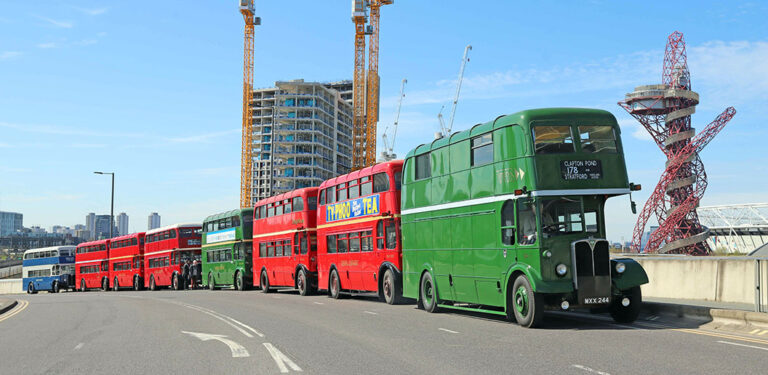RLH53 (MXX 253) : new in 1952
-
- Chassis : AEC Regent III – chassis no. 9613E6976
- Engine : AEC A217 9.6 litre diesel
- Gearbox : 4-speed air-operated pre-select
- Body : Weymann 53 seat (27 upper deck / 26 lower) - body no. M5557, buit at Addlestone
- Vehicle Classification: RLH – Regent Low Height
Withdrawn : 1970 (18 years)
On loan to the Museum : 2023
Status : fully-restored, operational and on display in the Museum




Photos
-
- RLH53 following extensive restoration, seen here at the LBM in October 2019 [David Bowker]
- RLH61 passing under the low bridge in Cranham [David Bowker]
- A gathering of surviving RLHs with RLH53 second in line [David Bowker]
Low railway bridges may require single-deck buses to be used, even if the route is busy enough to use a higher-capacity double-decker.
A batch of 30 low-height double-deck AEC Regent buses was built in 1950 originally for the Midland General Omn. Co. of Alfreton, Derbys. However, only 10 were actually required and the remaining 20 were purchased by London Transport. These buses could negotiate a bridge as low as 13ft 3½in (4.06m) – a standard-height double decker is around 14ft 6in (4.45m). These were put to work in the London Transport Country Area in green livery, at garages where low bridges presented difficulties on certain routes:
- Godstone garage for route 410 (Reigate - Bromley North)
- Amersham for route 336 (Chesham - Watford)
- Addlestone for several routes serving the Staines area
Mechanically, they were very similar to the huge fleet of AEC RTs but outwardly had a rather different look for London. Inside, passengers travelling on the top deck were cramped into four-across seating with a sunken gangway on the offside. This meant passengers in the offside of the lower-deck had to lower their heads when leaving their seats, to avoid hitting the ceiling.
London Transport ordered a further batch of 56, including RLH 53, the first of the type in red livery. It was allocated to Harrow in November 1952 for route 230 (North Harrow – Northwick Park), which ran under a low bridge in Headstone Lane, by Harrow & Wealdstone station.
Other members of the fleet of 76 RLHs were allocated to:
- Guildford, East Grinstead and Reigate (in green livery)
- Merton on route 127 (Morden - St Helier) for passing under Worcester Park railway bridge before it was rebuilt for higher vehicles
- Hornchurch for route 248 (Hall Lane - Cranham) passing under the low bridge at Cranham
RLH53 transferred to Dalston in 1959, for route 178 between Clapton Pond and Stratford via Hackney Wick and negotiating the low bridge in Carpenter’s Road (now part of the Queen Elizabeth Olympic Park.
Changes in legislation allowed longer and higher capacity single-deck buses, which together with a general decline in passenger numbers, led to RLH 53 being withdrawn in 1970 and put into storage.
It was sold together with RLH 69 and RLH 71, all three being exported to California, USA in January 1972. For forty years, it was on show at the Hill Country Wagons to Wings Collection, in Morgan Hill, CA. In 1993, the three were sold to a new owner for use on a sightseeing tour under the Murrieta Temecula Valley Tours name, but this venture proved abortive. Finally, in 2007, the three, by now in a somewhat weather-worn state, passed to a new owner in Oregon.
RLH53 was repatriated to the UK in 2012 and acquired by the London Bus Museum, to be put on display in dilapidated, as-rescued condition. When the Museum acquired RLH48 (in green Country Area livery), RLH53 passed in 2016 to Andy Totten, who had it restored by Martin James to the condition you see it in today.
It is on loan to the Museum for 12 months from March 2023.
Read more about RLH53's career and restoration here.
